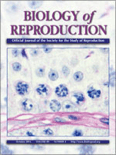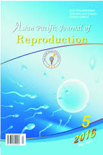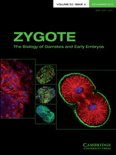
BIOLOGY OF REPRODUCTION
Scope & Guideline
Driving Discoveries in Reproductive Medicine
Introduction
Aims and Scopes
- Reproductive Physiology:
Investigations into hormonal control, signaling pathways, and physiological processes that govern reproduction, including studies on the ovarian cycle, spermatogenesis, and embryonic development. - Developmental Biology:
Research exploring the stages of development from gametogenesis to implantation and beyond, including the molecular and cellular dynamics involved in these processes. - Environmental Impact on Reproduction:
Studies assessing how environmental factors, such as endocrine disruptors and toxins, affect reproductive health and outcomes across species. - Genetics and Epigenetics in Reproduction:
Research focusing on genetic regulation, epigenetic modifications, and their implications for fertility, reproductive success, and developmental outcomes. - Stem Cells and Regenerative Medicine:
Exploration of stem cell technologies and their applications in reproductive biology, including in vitro gametogenesis and tissue engineering. - Comparative Reproductive Biology:
Comparative studies across species to identify unique reproductive strategies and mechanisms, providing insights into evolution and conservation.
Trending and Emerging
- Omics Technologies in Reproduction:
The application of genomics, transcriptomics, proteomics, and metabolomics to understand reproductive processes at a molecular level is on the rise, allowing for more detailed insights into fertility and developmental outcomes. - Microbiome and Reproductive Health:
Growing interest in the role of the microbiome in reproductive health, including its impact on fertility, pregnancy outcomes, and placental function, is becoming a prominent theme in recent publications. - Immune Factors in Reproduction:
Research exploring the interplay between the immune system and reproductive processes, including how immune responses affect implantation and pregnancy maintenance, is gaining traction. - Environmental Epigenetics:
Investigations into how environmental exposures can lead to epigenetic changes affecting reproductive health and outcomes are increasingly important, reflecting growing awareness of environmental impacts on biology. - Innovations in Assisted Reproductive Technologies (ART):
Emerging studies on novel ART methods, including advancements in cryopreservation, gamete selection, and embryo culture techniques, are becoming more prevalent as the field seeks to enhance reproductive success.
Declining or Waning
- Traditional Animal Models:
While animal models have been a staple in reproductive research, there has been a noticeable shift towards more innovative models and techniques, such as organoids and in vitro systems, resulting in decreased focus on traditional models. - Basic Fertility Assessments:
Research focusing solely on routine fertility assessments without integrating advanced technologies or molecular insights is becoming less common, as the field moves towards more comprehensive and mechanistic studies. - Single-Species Focus:
Studies that concentrate exclusively on single species without comparative or translational implications are waning, as interdisciplinary approaches that encompass multiple species are gaining prominence. - Historical Reproductive Pathologies:
There is a decline in studies that solely focus on historical or anecdotal reproductive pathologies without robust experimental backing, as the field increasingly emphasizes evidence-based approaches.
Similar Journals

Cell Journal
Bridging Disciplines in Cell and Molecular BiologyCell Journal is a leading interdisciplinary publication in the fields of Cell Biology, Developmental Biology, Molecular Biology, and Reproductive Medicine, published by ROYAN INST since its inception as an open-access journal in 2007. With an ISSN of 2228-5806 for print and 2228-5814 for electronic editions, it provides a vital platform for researchers and professionals to disseminate innovative findings and insights that shape our understanding of cellular processes and reproductive sciences. The journal boasts an impressive Scopus ranking, achieving a Q3 position in both Molecular Biology and Reproductive Medicine, highlighting its significance in the academic community. Situated in Tehran, Iran, Cell Journal encourages global collaboration through its accessible content, making cutting-edge research available to a diverse audience. As it converges from 2011 to 2024, the journal continues to emphasize the importance of thorough scientific inquiry, fostering advancements that drive both theoretical frameworks and practical applications in cell science.

Reproductive Medicine and Biology
Innovating insights in reproductive medicine and biology.Reproductive Medicine and Biology, an esteemed journal published by WILEY, stands at the forefront of advancements in the field of reproductive health and associated biological sciences. With an impact factor that underscores its relevance—ranking in Q1 for Reproductive Medicine and Q3 in Cell Biology—this journal is distinguished by its commitment to disseminating high-quality, peer-reviewed research since its transition to Open Access in 2002. Based in Japan, the journal caters to a global audience, providing vital insights into reproductive biology, therapeutics, and innovative practices. With Scopus rankings placing it at #22 out of 90 in Reproductive Medicine and a commendable percentile ranking, Reproductive Medicine and Biology aims to foster dialogue and knowledge transfer among researchers, professionals, and students, paving the way for breakthroughs in understanding reproductive health.

Human Reproduction Open
Fostering collaboration for a healthier future.Human Reproduction Open, published by Oxford University Press, is a prestigious open-access journal dedicated to advancing the field of reproductive health and medicine since its inception in 2017. With an E-ISSN of 2399-3529, the journal provides a vital platform for researchers, clinicians, and academics to disseminate innovative findings in obstetrics, gynecology, and reproductive medicine. It is recognized for its impactful contributions, holding an impressive rank of #3 out of 209 in Medicine - Obstetrics and Gynecology, #2 out of 90 in Medicine - Reproductive Medicine, and #1 out of 21 in Medicine - Embryology, placing it in the top percentiles of its respective categories. The open-access model ensures that research is freely accessible, fostering collaboration and knowledge sharing among professionals and students alike. With a commitment to high-quality, peer-reviewed publications, Human Reproduction Open plays a crucial role in shaping the future of reproductive health research and practice, serving as an essential resource for those dedicated to improving outcomes in this dynamic field.

JOURNAL OF MOLECULAR ENDOCRINOLOGY
Exploring Molecular Mechanisms in EndocrinologyJOURNAL OF MOLECULAR ENDOCRINOLOGY, published by BIOSCIENTIFICA LTD, is a prestigious academic journal that has made significant contributions to the fields of endocrinology and molecular biology since its inception in 1988. With an impressive impact factor that places it in the Q1 category for Endocrinology and Q2 for Molecular Biology, this journal is recognized for its rigorous peer-reviewed research that addresses key questions at the intersection of molecular mechanisms and hormonal regulation. The journal's accessibility within the Scopus rankings, notably positioned 45th out of 128 in Endocrinology, highlights its relevance and influence in shaping contemporary scientific discourse. Although the journal does not currently offer open access options, it remains an essential resource for researchers, professionals, and students eager to explore groundbreaking discoveries and advancements in the hormonal sciences. The JOURNAL OF MOLECULAR ENDOCRINOLOGY continues to pave the way for critical exploration and innovation, ensuring its place as a vital publication for the advancement of knowledge in molecular endocrinology.

Reproductive and Developmental Medicine
Fostering collaboration in reproductive and developmental research.Reproductive and Developmental Medicine is a pioneering open-access journal dedicated to advancing knowledge in the fields of reproductive medicine and developmental biology. Published by LIPPINCOTT WILLIAMS & WILKINS, the journal serves as a platform for researchers, clinicians, and graduate students alike, fostering collaboration and dissemination of innovative research findings. With an ISSN of 2096-2924 and E-ISSN 2589-8728, it has established a significant presence in the academic community since its inception in 2017. The journal is indexed in Scopus and achieved a category quartile ranking of Q3 in Obstetrics and Gynecology and Q4 in Reproductive Medicine as of 2023, highlighting its importance as a resource for cutting-edge studies and reviews in these vital areas. The journal's open-access model ensures that research is readily available to scholars and practitioners worldwide, thus enhancing the global discourse in reproductive health and development. This makes Reproductive and Developmental Medicine an invaluable resource for those dedicated to improving outcomes in obstetrics, gynecology, and reproductive health.

Reproduction and Fertility
Exploring the frontiers of fertility science.Reproduction and Fertility is a premier academic journal published by BIOSCIENTIFICA LTD, dedicated to advancing knowledge in the fields of reproductive sciences, obstetrics, gynecology, and related areas. Established with a focus on delivering high-quality research, this journal has quickly ascended in prominence, achieving a commendable Q2 ranking in multiple categories, including Embryology, Obstetrics and Gynecology, Reproductive Medicine, and Urology, as of 2023. With an E-ISSN of 2633-8386, Reproduction and Fertility aims to provide a valuable platform for researchers, professionals, and students alike, offering insights into the latest discoveries and innovations in reproductive health. Although currently not an open-access journal, it remains committed to disseminating important findings that can influence clinical practices and policy-making worldwide. Operating from its headquarters in Bristol, United Kingdom, the journal serves as an essential resource for anyone invested in understanding and improving reproductive health outcomes through rigorous academic research.

Reproductive Sciences
Pioneering Research for a Healthier FutureReproductive Sciences is a premier journal published by SPRINGER HEIDELBERG, dedicated to the field of obstetrics and gynecology. With its ISSN 1933-7191 and E-ISSN 1933-7205, the journal has established itself as a leading source of high-quality research and clinical insights since its inception in 2007, and continues to converge its scope into 2024. Currently ranked in the Q1 category for obstetrics and gynecology, it holds the 43rd position among 209 journals in the Scopus rankings, underscoring its influence and relevance within the medical community. This journal is particularly dedicated to advancing knowledge in reproductive health, providing a platform for innovative research and clinical practices through both traditional and open access options. Located in Switzerland with an address in Heidelberg, Germany, Reproductive Sciences is not just a publication; it is a vital resource for researchers, professionals, and students seeking to make impactful contributions to the field of reproductive health.

Asian Pacific Journal of Reproduction
Advancing Knowledge Across Species and DisciplinesAsian Pacific Journal of Reproduction is a dynamic open-access journal specializing in a diverse array of topics related to reproduction across various species, including humans, animals, and plants. Published by Wolters Kluwer Medknow Publications, this peer-reviewed journal has been committed to disseminating high-quality research since its inception in 2012. With an accessible ISBN of 2305-0500 and E-ISSN 2305-0519, the journal has rapidly established itself within the academic community, evidenced by its categorization in Q3 and Q4 quartiles across multiple fields, including Obstetrics, Gynecology, and Animal Science. Researchers are encouraged to contribute their findings to foster a deeper understanding of reproductive health and practices in the Asian Pacific region and beyond. The journal's inclusive scope and emphasis on interdisciplinary collaboration make it a crucial platform for professionals and scholars seeking to stay at the forefront of reproductive research.

International Journal of Fertility & Sterility
Empowering Insights in Obstetrics and GynecologyThe International Journal of Fertility & Sterility, published by ROYAN Institute, is a leading academic platform dedicated to advancing knowledge in the fields of obstetrics, gynecology, and reproductive medicine. With an ISSN of 2008-076X and an E-ISSN of 2008-0778, this Open Access journal has been making significant contributions to the scientific community since its inception in 2007. Based in Tehran, Iran, the journal showcases rigorous research and promotes interdisciplinary collaboration, addressing critical topics related to fertility, sterility, and reproductive health. As of 2023, it holds an impressive Q2 ranking in Obstetrics and Gynecology and a Q3 ranking in Reproductive Medicine, underscoring its relevance and impact in the academic sphere, with Scopus ranks placing it at #67 in Obstetrics and Gynecology and #32 in Reproductive Medicine. The journal's commitment to accessibility and quality is reflected in its global readership, making it an essential resource for researchers, healthcare professionals, and students seeking to enhance their understanding of fertility issues and reproductive technologies.

ZYGOTE
Elevating Early-Stage Research to New Heights.ZYGOTE is a prominent academic journal published by Cambridge University Press, focusing on the fields of Cell Biology and Developmental Biology. Established in 1993, this journal serves as a platform for high-quality research that advances our understanding of the complex processes that underlie cellular and developmental mechanisms. While currently classified in the Q4 quartile for both fields, ZYGOTE provides valuable insights and contributions from early-stage research to established studies, making it a noteworthy resource for researchers and professionals seeking to explore innovative developments in biology. Although it does not offer open access, the journal maintains rigorous peer-review standards to ensure the integrity and relevance of the published work. With its ongoing commitment to disseminating knowledge, ZYGOTE plays a significant role in the scientific community, fostering collaboration and inspiration among students, researchers, and professionals alike.